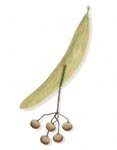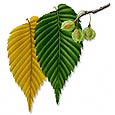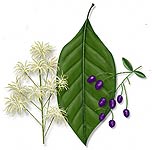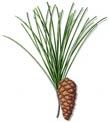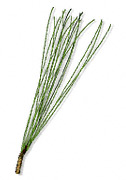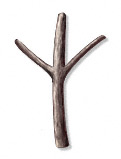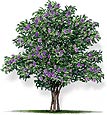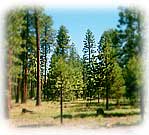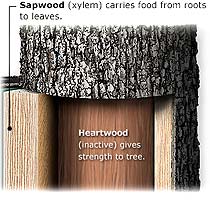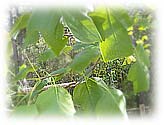Tree Dictionary


Abiotic - a non-living factor or element found in an environment
Absentee Landowner - landowners who do not live in the county in which their land is located
Access Road - a temporary or permanent access route for vehicles into forestland
Acidic Soils - Soils whose pH is less than 7
Acre - a unit of land measurement that contains 43,560 square feet. Sometimes expressed as 10 square chains
Afforestation - the establishment of trees on an area that was not forested before
Alien Species- species that do not originate in the area or region from which they are found growing; also known as introduced, non-native or exotic species
Alkaline Soils - Soils whose pH is greater than 7
All-aged Stand (Uneven-aged) - a stand of trees with three or more different age classes
Alternate- leaves or branches that are arranged alternate one another; not opposite
Angiosperm - flowering plants; “enclosed seeds” in a flower
Annuals - plants that live or grow for only one year or one growing season
Apical Meristem - A meristem at the tip of a plant shoot or root that causes the shoot or root to increase in length.
Artificial Regeneration - replacing the harvested forest by planting seed or seedlings
Aspect - the side or surface of a mountain facing a given direction

Backfire - a burning technique used to reduce the amount of fuel in the forest. The fire is set to burn against the wind or back into the fuel as the wind blows the flames away from the fire
Barriers - obstructions to pedestrian, horse, and/or vehicular traffic. They are intended to restrict such traffic to a specific location
Basal Area - the sum of the cross sectional areas in square feet of the trees on an acre when measured at 4.5 feet above the ground
Basic Soils - another term for alkaline soils or those with pH greater than 7
Bearing Capacity - maximum load that a material (soil) can support before failing
Bedding - a site preparation method in which special disking equipment is used to concentrate surface soil and forest litter into a ridge or bed elevated six to ten inches (6-10) above the normal soil level on which forest seedlings are to be planted
Best Management Practices (BMPs) - a practice or combination of practices determined to be an effective and practicable (including technological, economical, and institutional considerations) means of preventing or reducing the amount of water pollution generated by non-point sources
Biotic- living organisms found in an environment
Board Foot- a piece of wood measuring 1 foot x 1 foot x 1 inch. The term is commonly used to measure the amount of wood in trees, sawlogs or boards
Bole - the main trunk of the tree
Bolt - a short log or squared timber cut from a log that is less than 8 feet.
Borrow Pit - that area, usually adjacent and parallel to a road, from which soil is removed to build up the road bed
Bottom Lands - a term often used to define lowlands adjacent to streams and rivers
Broad-Based Dip - a surface drainage structure specifically designed to drain water from an access road while allowing vehicles to maintain normal travel speeds
Buck - to saw felled trees into predetermined lengths
Bucking - the process of cutting a tree into shorter lengths
Buffer Strip - a narrow piece of land bordering an area such as a stream or road with forestry practices that are different from adjacent areas
Bunching - grouping of trees or logs together to form a load before being transported
Bundle Scar - a small scar in a leaf scar left by a vascular bundle
Cambium - a layer of cells located inside the bark between the xylem (wood) and phloem (inner bark)
Caliche soil - is a hardened mineral of calcium carbonate. It forms when rain dissolves calcium found in rocks and minerals, carrying it down into the soil, so layers of deposits build up over the years.
Canopy - the layer of covering in a forest made up of tree crowns, from the top of the tallest tree in a forest or the top of the shortest tree in a forest this is known as the canopy. The canopy can be described in three layers, upper, middle and lower
Carrying Capacity - the maximum number of individuals of a wildlife species an area can support during the most unfavorable time of the year
Chain - a unit of measure used by foresters and surveyors that equals 66 feet
Chambered Pith- a pith that is divided into empty chambers by cross partitions
Channel - a natural stream that conveys water; or a ditch excavated for the flow of water
Check Dam - a small dam constructed in a gully or other small watercourse to decrease the stream flow velocity, minimize channel scour and promote deposition of sediment
Chip-n-saw - a mill process that allows small diameter trees 7 to 10 inches, DBH, to be converted into lumber and into chips for pulp and paper manufacturing
Chlorophyll - the green pigment of plant cells, which is the receptor of light energy in photosynthesis
Clearcut - a method of harvest or a silvicultural system, where all the trees are removed and involves the replanting or natural regeneration of species leading to the establishment of an even-aged stand. This method is usually used for species that require full sunlight for growth
Co-dominant - trees with medium crowns forming the upper level of the crown cover and receiving full light from above and partial light on the sides
Commercial Thinning - the removal of marketable trees from maturing young growth to reduce competition and accelerate growth of the remaining trees
Commercial Timber Land - land capable of producing industrial crops of timber and not excluded from such use by legislation or regulation
Competition - the struggle among trees and other plants for nutrients, water, light, space, and other requirements for existence
Compound Leaf - a leaf composed of several leaflets attached to a rachis or stem for a compound leaf
Conifer - trees with needles or scales instead of leaves, usually evergreen, and often called softwoods; gymnosperms bearing cones
Conservation- the wise-use of natural resources for long-term benefits to society; the use of natural resources in a way to assure their continuing availability to future generations
Consulting Forester - a self-employed registered forester who provides landowners with professional forestry advice and services for a fee
Contamination - a general term signifying the introduction into water of micro-organisms, chemicals, organic wastes or sewage, which renders the water unfit for its intended use
Contour - an imaginary line on the surface of the earth connecting points of the same elevation. A line drawn on a map connecting points of the same elevation
Coppice - a regeneration method in which the forest stand regenerates primarily from stump and root sprouts
Cord - a stack of round or split wood containing 128 cubic feet of space, including wood, bark, and air space (4’ x 4’ x 8’)
Cost Share Program - a program where a group (usually a government agency) shares in the cost of carrying out forest management practices on private property as an incentive to owners to make a long-term investment in their land
Crop Trees - trees selected to be grown for the final harvest cut
Crown - the branches and foliage of a tree
Crown Ratio - the ratio of the tree crown to the total height of the tree
Cruise - a survey of forest land to estimate species, stocking, volumes, products, size, and quality levels of standing timber
Cubic Foot - a volume measurement containing 1728 cubic inches of material such as a piece of wood measuring 1 foot on
each side. A cubic foot of wood contains 12 board feet.
Cull - a tree or log of merchantable size that has no market value because of shape, damage, or species
Culvert - a conduit or pipe through which surface water can flow under roads
Cut - portion of land surface or area from which soil has been removed or will be removed by excavation; the depth below original ground surface to excavated surface
Cut-and-Fill - process of earth moving by excavating part of an area and using the excavated material for adjacent embankments or fill areas
Cutting Cycle - the planned time interval between major harvesting operations in the same stand
DBH - an abbreviation for tree diameter at breast height (4.5 feet above the ground)
Deciduous Tree - a tree that loses all its leaves at some time during the year
Deck - a concentration area during a logging operation where logs are gathered for processing and transportation
Decomposition- the break down or separation of a substance into basic elements
Delimbing - removing limbs from a felled tree
Delivered Price - price per cord or thousand board feet at the first point of delivery. Price includes the cost of the trees, logging experience, and transportation
Dendrochronology- the study of growth rings in trees and aged woods; the science of dating events and variations in the environment in former periods by comparing growth rings
Dendrology- the study of trees. A sub-discipline of botany involved in the identification and classification of woody plants in relations to geographical distribution
Desert - a region or habitat lacking rainfall with limited amounts of vegetation
Detritus - any disintegrated material; includes dead plants, animals or fecal material
Diameter - the length of a straight line going from one side of a tree trunk to another and passing through the center
Diameter at Breast Height- four and one-half feet above ground-level, the height where a tree’s diameter is measured (also known as DBH)
Diameter Limit Cut - a selection method of timber harvesting where all merchantable trees above a specified minimum diameter are harvested; usually specified at stump height
Diaphragm Pith- a pith that displays regularly spaced disks of horizontally elongated cells
Dibble bar - also called a planting bar. A tool used for planting bare-root seedlings by hand
Dioecious - plants having only male or female flowers or cones per plant
Direct Seeding - a method of artificial regeneration in which tree seeds are sown on a prepared site
Diversion - a channel with a supporting ridge on the lower side constructed across or at the bottom of a slope for the purpose of intercepting surface runoff
Diversion Ditch - a drainage depression or ditch built across the top of a slope to divert surface water from that slope
Dominant - a tree with a crown extending above the general level of the canopy and receiving full sunlight from above and also from the sides
Ecosystem- the interaction of a biological community and its non-living environment
Edge Habitat- the transition zone between two different habitats; for example, the line between a forest and pasture
Endangered Species - a species where the remaining members may not be sufficient to reproduce enough offspring to ensure survival of the species
Erosion - the process by which the surface of the earth is worn away by the action of water, glaciers, winds, waves, etc
Elevation - the altitude of a place above sea level or ground level
Erosion Classes (soil survey) - a grouping of erosion conditions based on the degree of erosion or on characteristic patterns. Applied to accelerated erosion, not to normal, natural, or geological erosion. Four erosion classes are recognized for water erosion and three for wind erosion
Even-aged Management - a system of management leading to the trees in the forest being approximately the same age
Evergreen- a tree that retains some or all of its leaves throughout the year

Fascicle - a cluster or bundle, for example loblolly has three needles per fascicle
Felling - the process of severing trees from stumps
Firebreak - a natural or man-made opening used to prevent the spread of fire
Fill Slope - the surface area formed where soil is deposited to build a road or trail
Firebreaks - naturally occurring or man-made barriers to the spread of fire
Firelane - a permanent barrier to the spread of fire which will be maintained over time for the specific purpose of stopping the spread of fire or for access to an area for the control of a fire
Fireline - a barrier used to stop the spread of fire constructed by removing fuel or rendering fuel inflammable by using water or fire retardants
Fissures - A long narrow opening; a crack or cleft in the bark
Flowers - a modified, determinate short shoot with a stem, sterile leaves and reproductive leaves
Forage - leaves, stems, buds, and barks that can be eaten for food and energy
Ford- submerged stream crossing where tread is reinforced to bear intended traffic. A place where a stream may be crossed by vehicle
Forest - a plant community in which the dominant vegetation is trees and woody plants
Forest Chemicals- chemical substances or formulations that perform important functions in forest management, and include fertilizers, herbicides, repellents, and other chemicals
Forest Management - the art and science of applying technical forestry principles and practices and business techniques to the management of a forest
ForestManagement Plan - usually a written document that includes overall guidelines and recommended management practices to meet a landowner’s objectives
Forest Practice - an activity relating to the growing, protecting, harvesting, or processing of forest tree species on forest land and to other forest management aspects such as wildlife, recreation, etc.
Forest Road - an access route for vehicles into forest land
ForestSite - refers to the combination of soil and topography
ForestStand - a group of trees similar enough to allow treatment as a single unit in a forest management plan
Forestry - the science, art, and practice of managing, and using trees, forests and their associated resources while sustaining these resources for this and future generations
Fruit - a ripened ovary, usually containing seeds
Furrowing- a site preparation method involving plowing of a trench in preparation for reforestation

Germinate- the process of a plant to sprout, put forth shoots and begin to grow
Grade - the slope of a road or trail expressed as a percent of change in elevation per unit of distance traveled
Growing Stock - all live trees in a forest or stand, including saw timber, pole timber, saplings, and seedlings
Gully Erosion - erosion process whereby water accumulates in narrow channels, and over short periods of time removes soil from this narrow area to substantial depths (one foot plus)
Gymnosperm - seed plants bearing “naked seeds”; usually found in a cone

Habitat - the natural environment of a specific plant or animal containing all the necessary resources for the plant or animal to live, grow and reproduce
Hand Planting - the planting of tree seedlings with simple hand tools
Hardpan - a natural or man-made solid clay layer within the soil resulting in poor drainage and poor plant growth
Hardwood - a term describing broadleaf trees such as oaks, maples, ashes, and elms
Harvesting - the felling, loading, and transportation of forest products, roundwood or logs
Haul road - road used to haul wood products. May vary from paved to primitive but are permanent woods (tertiary) roads
Headwaters (Head) - the point on a stream above which the average annual flow is less than five (5) cubic feet per second
Herbicides - chemicals used to kill or slow down the growth rate of plants. Herbicides should be applied by qualified applicators and by following label directions
High Grading- the practice of removing only the biggest and best trees from a stand during a harvest operation and leaving only the poorest and the lowest quality culls on the site to grow

Improvement Cut - a type of intermediate harvest with the primary objective of improving the remaining stand
Imbricate- overlapping; usually referring to multiple bud scales that overlap one another
Increment Borer - a shallow auger-like instrument used to bore into a tree trunk to remove a wood core that shows the tree’s growth rings
Intermediate Cut - the removal of trees from the forest sometime between establishment and final harvest with the primary objective of improving the quality of the remaining forest stand
Intermediate Trees - trees shorter than dominant and co-dominant trees but with crowns extending into the crown cover formed by the dominant and co-dominant trees
Intermittent - that part of the drainage network, with a clearly defined stream channel, which provides flow continuously during some seasons of the year, but little or no flow during the remainder of the year
Intolerant - plants that will not grow in the shade of other plants or trees
Invasive species- a plant, animal or other organism that is typically non-native to a particular ecosystem and whose introduction causes or is likely to cause harm to the economy, environment, or human health

J-Root - the growth form of tree roots resulting from improper hand planting where some or all of the roots are bent upward as the tree is placed in the ground

Landing - a place where logs are assembled for temporary storage, loading, and subsequent transportation
Leave Trees - trees left in or immediately adjacent to a harvest area to reseed the area
Leaf - Primary lateral appendage of a stem; usually flattened and photosynthetic
Leaflet - A division of a compound leaf; or small leaves that are apart of a single compound leaf
Leaf Scar - a scar left on a twig when the leaf drops
Log - a unit of measure of the trunk portion of a tree equal to 16 feet in length
Logging - the felling and transportation of wood products from the forest to a delivery location
Logging Debris/Slash - the unwanted, or unutilized and generally unmarketable accumulation of woody material such as large limbs, tops, cull logs, and stumps that remain in the forest as residue after logging
Log Rule - an equation used to calculate the amount of lumber that can be cut from logs
LowWaterBridge - a stream crossing structure built with the expectation that, during periods of high water or flood, water will flow over the structure
Lump-Sum-Sale - that sale of a defined area of standing trees for a set price
MBF - an abbreviation meaning one thousand board feet
Mechanical Planting - planting tree seedling with a planting machine that is pulled by a tractor
Merchandising - the practice of separating timber into product classes thereby increasing value for the timber
Merchantable - that part of a tree that can be turned into a product and sold for a profit
Merchantable Timber - a stand where the trees are of sufficient size and volume to provide a commercial cut
Meristem - The undifferentiated plant tissue from which new cells are formed, as that at the tip of a stem or root.
Mill Scale - paying the landowner for the volume of lumber produced at the sawmill
Mineral Soil - organic free soil that contains rock less than 2 inches in maximum dimension
Monecious - Plants having both male and female flowers or cones per plant
Mortality - expressed as trees or percent of growth dying within a certain time frame
Mulch - a natural or artificial layer of plant residue or other materials covering the land surface which conserves moisture, holds soil in place, aids in establishing plant cover, and minimizes temperature fluctuations
Mulching - providing any loose covering for exposed forest soil, using organic residues, such as grass, straw or wood fibers to protect exposed soil and help control erosion
Multiple Use - refers to shared use of managed forests for many benefits, such as wood products, wildlife, watershed benefits, recreation, forage, aesthetics, or clean air

Native species- a species that occurs naturally to a region or habitat
Natural Stand - a stand of trees resulting from natural seed fall or sprouting
Non-point Sources - sources of water pollution which are: (1) induced by natural process, including precipitation, seepage, percolation, and runoff; (2) not traceable to any discrete or identifiable point; and (3) best controlled through the utilization of Best Management Practices, including planning and processes techniques
Non-native species- species that do not originate in the area or region from which they are found growing; also known as introduced, alien or exotic species
Nutrients - mineral elements in the forest ecosystem such as nitrogen, phosphorus, and potassium usually in soluble compounds that are present naturally or they may be added to the forest environment as forest chemicals, such as fertilizer

Old-growth Forest - a forest that has never been changed by management or harvesting
On the Stump - standing, uncut timber
Opposite - leaves or branches that are arranged directly opposite on another; not alternate
Ordinary High Water Mark - the mark on the shores of all waters, which will be found by examining the beds and banks and ascertaining where the presence and action of waters are so common and usual, and so long continued in all ordinary years, as to mark upon the soil a distinct character
Organics - particles of vegetative material in the water which can degrade water quality by decreasing dissolved oxygen and by releasing organic solutes during leaching
Outfall Protection - a rip rap or aggregate placed at the outlet of a culvert or water-control device to protect that area from erosion damage due to the force or velocity of the outlet of water
Outslope - the downhill side of a road where the side of the road slopes with the hill at or near the natural contour and runoff is allowed to drain down the hill without being channeled into a ditch or other water-control device. Outslopes are usually associated with a road in steep terrain which is literally cut into the side of the hill
Overtopped - trees within a stand with crown entirely below the crowns of other trees in the stand

Partial Cut - a silvicultural cutting system, which removes at any one time less than the total tree stand
Perennial - that part of the drainage network which provides water flow at all times except during extreme drought
Pesticides - a collective term meaning chemicals, including herbicides and insecticides, which are used to kill pests such as weeds, diseases, insects, or unwanted trees
pH - A measure of acidity or alkalinity of soil. A pH of 7 is neutral, acidic soils have a pH of less than 7 and alkaline soils have a pH of greater than 7.
Phloem- also known as inner bark, phloem transports dissolved nutrients from the leaves to the other parts of trees and woody plants
Photogrammetry - the science of interpreting and making reliable measurements from aerial photographs
Photosynthesis - the process by which plants manufacture simple sugars in the presence of sunlight, carbon dioxide and water. Chlorophyll is essential to the process
Plantation - an artificially reforested area established by planting or direct seeding and usually made up of a single species
Point Source Pollution - sources of water pollution (generally a man-caused pollutant) which can be traced to a specific place or location (i.e. a pipe)
Pole Timber - trees with diameters larger than 4 inches DBH with a very straight trunk and very little taper
Pollutant - dredged soil, solid wastes, incinerator residue, sewage, garbage, sewage sludge, chemical wastes, biological materials, radioactive materials, heat, wrecked or discarded equipment, rock sand, cellar dirt, and industrial, municipal, and agricultural waste discharged in the water. (P.L. 92-500 Section 502(6))
Pollution - the presence in a body of water (or soil or air) of substances of such character and in such quantities that the natural quality of the environment is impaired or rendered harmful to health and life or offensive to the senses
Pith- the central portion of the twig
Pre-Commercial Thinning - practiced in very young stands to decrease the number of trees and reduce competition for water and nutrients
Prescribed Burning - the controlled use of fire to achieve forest management objectives
Prescription - usually a written recommendation by a forester prescribing present and future management practices for a forest stand
Preservation- the non-consumptive use of natural resources; an attempt to keep natural resources in an unaltered state
Primary Road - a high specification permanent road which is maintained periodically and serves as a main artery in a network of roads
Pruning - the removal of branches from standing trees to produce higher quality knot-free clear wood
Pulpwood - trees cut primarily for conversion into wood pulp for the manufacture of paper, fiberboard, or other wood fiber products

Rachis - Axis of a compound leaf
Reforestation - the regeneration of new trees on an area where the forest has been or will be removed; either naturally by seed fall or artificially by direct seeding or planting seedlings
Regeneration - the practice of replacing old trees either naturally or artificially with new trees
Regeneration Cut - a harvest operation to remove the old trees and leave environmental conditions favorable for the establishment of reproduction
Release Cutting - an operation to release young desirable trees from competition with other trees of the same size or larger and overtopping trees
Renewable resources - are a naturally occurring raw material or form of energy which has the capacity to replenish itself through ecological cycles and sound management practices. The sun, wind, falling water and trees are examples of renewable resources
Residual Stand - trees, often of saw log size, left in a stand after logging to grow until the next harvest
Residual Trees - live trees left standing after the completion of harvesting
Rill Erosion - an erosion process in which numerous small channels only several inches deep are formed; occurs mainly on disturbed and exposed soils
Riparian - vegetation that grows close to water; creeks, springs, small lakes or swamps.
Rip Rap - aggregate placed on erodible sites to reduce the impact of rain or surface runoff on these areas
Rolling Dip - a shallow depression built diagonally across a light duty road or trail to divert surface water runoff from the road or trail
Rotation Period - the number of years required to establish and grow trees to a specified size, product or condition of maturity
Runoff - in forest areas, that portion of precipitation that flows from a drainage area on the land surface or in open channels
Ruts - depressions made by the tires of vehicles such as skidders, log trucks, pickups, etc. usually under wet conditions

SaleArea - the land area that contains the trees to be sold and any other area affected by the harvesting operation
Salvage Cut - the harvesting of dead or damaged trees or those in danger of being killed so they can be sold for some economic value
Sanitation Cut - the harvesting or destruction of trees infected or highly susceptible to insects or diseases to protect the rest of the forest stand
Sapling - a young tree normally more than 4.5 feet tall and less than 4 inches in diameter
Sawlog - a log large enough to produce a sawn product, usually at least 10 to 12 inches DBH and 8 inches or larger at the small end
Sawtimber Stand - a group of trees with many or most of the trees large enough to be sawn into lumber
Scarify - to break up the forest floor and top soil preparatory to natural or direct seeding (or the planting of seedlings)
Secondary Road - a road constructed for a specific use or single operation and normally abandoned upon completion of the operation
Section - a land measurement term for a square land area containing 640 acres with each side measuring one mile
Sediment - solid material in suspension, being transported or moved from its original site.
Seed Tree Method - a natural regeneration method where all but a few trees are removed from the harvest area at one time. The remaining trees are carefully selected high quality trees uniformly distributed to provide seed to establish a new forest stand
Seedbed - the soil prepared by natural or artificial means to promote the germination of seed and the growth of seedlings
Seedling - usually defined as a tree less than 1 inch DBH, which has grown from seed, either naturally or in a nursery
Selection Method - a natural regeneration method where individual trees or small groups of trees are harvested at periodic intervals based on their physical condition or degree of maturity
Set - a place where logs are assembled for temporary storage, loading, and subsequent transportation
Setting - the forest land area within an individual harvesting unit in which skidding is directed to one or more landings on a forest road
Shade Tolerance - a tree’s capacity to develop and grow in the shade of and in competition with other trees
Shearing - a site preparation method that involves cutting brush, trees, and other vegetation at the ground level using tractors equipped with angled or v-shaped cutting blades
Sheet Erosion - the removal of a fairly uniform layer of soil removed from the soil surface by water runoff
Sheet Flow - runoff from a rainstorm intense enough to cause direct overland flow of water before entering a receiving stream
Shelterwood Method - a natural regeneration method in which the trees are removed in a series of two or more cuttings to allow the establishment and early growth of the new seedlings under the partial shade and protection of the older trees
Shoot - The part of a vascular plant that is above ground, including the stem and leaves. The tips of shoots contain the apical meristem.
Sidecast - the material or the act of moving excavated material to the side and depositing such material laterally to the line of movement of the excavating machine
Silvics - the study of the life history and general characteristics of forest trees and stands with particular reference to locality factors, as a basis for the practice of silviculture (SAF Interpretation)
Silvicultural Activities - all forest management activities, including intermediate cuttings, harvest, log transport, and forest road construction (EPA interpretation)
Silviculture - the science and art of cultivating (i.e. growing and tending) forest crops, based on a knowledge of silvics; and more particularly, the theory and practice of controlling the establishment, composition, constitution and growth of forests (Society of American Foresters Interpretation, www.safnet.org)
Simple Leaf - a leaf of one piece; not compound
Site Index - a measure of site quality based on the height of the dominant and codominant trees of the stand at a specified age (usually 25 or 50 years)
Site Preparation - any treatment of a forest site to get it ready for planting, direct seeding, or natural regeneration such as clearing, chemical vegetation control, burning, disking, bedding, windrowing, or raking
SkidTrail - a route over which logs are moved to a landing or road
Slope - degree of deviation of a surface from the horizontal, measured as a numerical ratio, percent, or in degrees. Expressed as a ratio, the first number is the horizontal distance (run) and the second is the vertical distance (rise), as 2:1. A 2:1 slope is a 50 percent slope. Expressed in degrees, the slope is the angle from the horizontal plane, with a 90 degree slope being vertical (maximum) and a 45 degree slope being a 1:1 slope
Softwood- a coniferous tree or cone bearing tree
Soil - the unconsolidated mineral and organic material on the immediate surface of the earth that serves as a natural medium for the growth of land plants
Soil compaction- the compression of soil to a smaller volume.
Soil Conservation - using the soil within the limits of its physical characteristics and protecting it from unalterable limitations of climate and topography
Soil Productivity - the output or productive capability of a forest soil to grow timber crops
Southern Yellow Pines - most often refers to loblolly pine, shortleaf pine, longleaf pine, and slash pine
Species - a population of organisms composed of related individuals that resemble one another and are able to breed among themselves, but are not able to breed with members of another species
Stand - a group of trees occupying a given area and sufficiently uniform in composition, age, and condition so as to distinguish them from adjoining forest areas
Stem - the trunk of the tree
Stewardship Forest - property being managed in keeping with a plan prepared by resource professionals that considers landowner objectives and USDA Forest Service Stewardship standards
Stocking - the number of trees in a forest stand
Stomata- microscopic openings on the surface of leaves that allow gas to pass in and out
Stream - a well-defined natural channel that has a flow anywhere below its headwaters greater than 5 cfs at least 50% of the time (EPA - Army Corp Section 404). A permanently or intermittently flowing body of water that follows a defined course
- ephemeral stream (or drain) means a stream that flows only during and for short periods following precipitation and flows in low areas that may or may not have a well-defined channel
- intermittent stream means a stream that flows only during wet periods of the year (30-90% of the time) and flows in a continuous, well-defined channel
- perennial stream means a stream that flows throughout a majority of the year (greater than 90% of the time) and flows in a well-defined channel
Streambanks - the usual boundaries, not the flood boundaries, of a stream channel. Right and left banks are named facing downstream
Streamside Management Zone (SMZ) - forested area immediately adjacent to stream channels. Managed for forest resources with specific attention given to measures that can be taken to protect both instream and downstream water quality as well as other beneficial uses. The purpose of an SMZ is to reduce the quantity of sediment and logging wastes reaching the streams and to provide shade to prevent water temperature increases
Stumpage - standing merchantable timber
Succession - the gradual replacement of one plant community by another
Superior seedlings - seedling grown from seed produced by parent trees of high genetic quality
Sustainable Forest Management - the management of forestland to meet the needs of the present without compromising the ability of future generations to meet their own needs
Sustainable Forestry Initiative - an American Forest and Paper Association (AFPA) program started in 1994 and implemented as an industry standard in 1997 with a commitment to sustainable forestry that is open to public monitoring and evaluation

Thermal Pollution - a temperature rise in a body of water sufficient to be harmful to aquatic life in the water
Thinning - cutting or removing certain trees to reduce competition and allow the remaining trees to grow faster
Threatened Species - a species where the population is declining to dangerously low numbers but still has enough members to maintain or increase its population
Timber Marking - the process of designating trees to be cut by spraying each with a spot of brightly colored paint at its base and another spot at eye level
TimberSale - activities dealing with the exchange of timber from one party to another. Common sale methods are (1) Lump sum- a specified area or volume of standing trees is sold for a cash price before cutting and (2) Unit Sale- the buyer pays a specified amount for each unit of timber cut
T.S.I. (Timber Stand Improvement) - the performance of practices such as pruning, thinning, and weeding to improve the quality of a forest stand
Tract - a parcel of land considered separately from adjoining land because of differences in ownership, timber type, management objectives, or other characteristics
Transpiration- the process by which water evaporates from plant tissues
Tree - a woody plant having one well defined trunk and crown and reaching a height not less than 10 feet
Tree Crown - a collective term for the limbs, branches, and leaves of a tree
Tree Farm - a forest ownership where management practices are performed to promote the continuous production of products and services from the ownership
Tree Improvement - the practical application of forest genetics, usually done by testing natural trees and determining which trees grow best when planted on specific sites
Turnout - (1.) a widened space in a road to allow vehicles to pass one another. (2.) A drainage ditch which drains water away from roads

Uneven-aged Management- management of forests in such a way as to get a spread of age classes ranging from small seedlings to mature trees
Upland- higher ground of a region; elevated above other land

Valvate - Meeting at the edges and not overlapping, as in bud scales

Waste - materials and substances discarded as worthless to the user
Water Bar - the portion of a dirt road where the soil is formed as a raised bar across the road that diverts surface water runoff and prevents soil erosion
Water Body - an area of standing water with relatively little or slow movement (ponds, lakes, bays)
Water Course - a definite channel with bed and banks within which concentrated water flows continuously or intermittently
Water Pollution - contamination or other alteration of the physical, chemical or biological properties of any natural waters of the state, or other such discharge of any liquid, gaseous or solid substance into any waters of the state, as well, or is likely to create a nuisance or render such waters harmful or detrimental or injurious to public health, safety or welfare, or to domestic, commercial, industrial, agricultural, recreational, or other legitimate beneficial uses, or to livestock, wild animals, birds, fish or other aquatic life (EPA definition)
Water Quality - a term used to describe the chemical, physical, and biological characteristics of water, usually in respect to its suitability for a particular purpose
Water Quality Standards - texas Water Quality Standards and criteria contained therein
Watershed Area - all land and water within the confines of a drainage divide or a water problem area consisting in whole, or in part, of land needing drainage or irrigation
Waterway - a way or channel for water or the movement of water
Wetlands - the U.S. Army Corps of Engineers and the U.S. Environmental Protection Agency jointly define wetlands as Those areas that are inundated or saturated by surface or ground water at a frequency and duration sufficient to support, and that under normal circumstances do support, a prevalence of vegetation typically adapted for life in saturated soil conditions. Wetlands generally include swamps, marshes, bogs, and similar areas.
Wildfire Control - actions taken to contain and suppress uncontrolled fires
Wildfires - uncontrolled fires occurring in forestland, brushland, and grassland
Windrow - slash, residue, and debris raked into piles or rows
Wing Ditch - a water turnout or diversion ditch constructed to move and disperse water away from the road and side ditches into adjacent undisturbed areas so that the volume and velocity of water is reduced on slopes
Xylem - the water conducting tissue found in woody plants. Xylem transports water, stores nutrients and provides structural support for trees and woody plants

Yarding- Method of log transport from harvest area to storage landing



